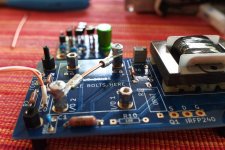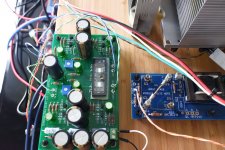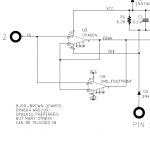Papa says 'this amp will make you go through your entire record collection'. A corollary to that, 'this amp will also make you throw away your entire CD collection'. ;-)
Back in the day I ripped a bunch of my CDs and put them in itunes. Now I find that any crappy youtube file sounds 10x better than that. At this point I hope it's itunes file compression!
I hope that new better formats are available now so I can re-rip my CDs.
Back in the day I ripped a bunch of my CDs and put them in itunes. Now I find that any crappy youtube file sounds 10x better than that. At this point I hope it's itunes file compression!
I hope that new better formats are available now so I can re-rip my CDs.
Zen did what? Not following your line of thought...
Nothing, never mind.
I seemed to recall Zen put the opto 4N35 (or whatever) in the M2 schematic thread and saying that bias should be 1.5A-2A. When it turned out to be only ~1.3A. It's all me, not Zen.
Back in the day I ripped a bunch of my CDs and put them in itunes. Now I find that any crappy youtube file sounds 10x better than that. At this point I hope it's itunes file compression!
Correct. The default iTunes compression was pretty bad. Lots of audible artifacts and overall lesser quality.
WAV and Apple Lossless is what I used, sounds as good as the CD.
Heck you could just make a very high (maxed out) sample rate mp3 and it's worlds better than the default.
If you originally ripped your CDs using the iTunes default settings, then they are heavily compressed, and won’t sound very good on a high resolution audio system. The best format available with iTunes is Apple Lossless Audio Codec. Also known simply as Apple Lossless and abbreviated as ALAC. This preserves all the information from the CD, such as it may be, and cuts file size in half relative to the AIFF format, which is a direct copy.
There are other lossless formats which can be ‘transcoded’ from ALAC, depending on file type support of your digital audio player. Though re-ripping your CDs will be time consuming, it will be very worthwhile.
There are other lossless formats which can be ‘transcoded’ from ALAC, depending on file type support of your digital audio player. Though re-ripping your CDs will be time consuming, it will be very worthwhile.
Papa says 'this amp will make you go through your entire record collection'. A corollary to that, 'this amp will also make you throw away your entire CD collection'. ;-)
Back in the day I ripped a bunch of my CDs and put them in itunes. Now I find that any crappy youtube file sounds 10x better than that. At this point I hope it's itunes file compression!
I hope that new better formats are available now so I can re-rip my CDs.
I took the time to rip all my CDs over as Flac and mostly ALAC files. And archived the discs to the storage unit. In a resolving system, and a good recording, there is a fair sized improvement over poorly done compressed files (Apple AAC can be bad in the lower rez end) Sure, from your iPhone to iBuds you probably can’t tell the difference (most consumers), but we are aiming higher.
Still, I agree that vinyl really sounds good with this amplifier.
Question about when you guys try newly built daughter cards. After finishing a board, do you test it before installing it? Or do you just put it in and see if it plays?
I ask because I just finished the Austin and installed them into my M2x, but want to be sure an improperly built daughter card will not damage the amp. My amp works great with the Ishikawa and Tucson.
I ask because I just finished the Austin and installed them into my M2x, but want to be sure an improperly built daughter card will not damage the amp. My amp works great with the Ishikawa and Tucson.
Try the google search shown below. It found lots of "hits" including post #2054 in this thread, a message which appears to fall smack in the middle of a discussion about testing M2x daughter cards. Some of the other google search hits might be even more helpful but I didn't read them carefully; only eyeballed them very quickly just now.
I doubt it helps, but my own procedure is to build a separate test fixture PCB into which a daughter card can be bolted. The test fixture includes lots of BNC connectors for connection to signal generators and oscilloscope cables. It's only a viable option for those who (a) can lay out their own PCBs; (b) do enough tests of daughter cards to justify the effort and expense of a dedicated test fixture including variable ±30 volt, 3 amp, lab power supply, 40 MHz signal generator, and dual channel oscilloscope.
_
I doubt it helps, but my own procedure is to build a separate test fixture PCB into which a daughter card can be bolted. The test fixture includes lots of BNC connectors for connection to signal generators and oscilloscope cables. It's only a viable option for those who (a) can lay out their own PCBs; (b) do enough tests of daughter cards to justify the effort and expense of a dedicated test fixture including variable ±30 volt, 3 amp, lab power supply, 40 MHz signal generator, and dual channel oscilloscope.
_
Attachments
Last edited:
Test fixture.
Holy crap. Certainly a better method than "hope"'. But it sounds like masters level stuff and I'm on my first engineering circuit analysis class. I wonder how many years I am away from that?🙁
Hopefully I'll be listening to music before then😀
Keep us posted.
Don
Try the google search shown below. It found lots of "hits" including post #2054 in this thread, a message which appears to fall smack in the middle of a discussion about testing M2x daughter cards. Some of the other google search hits might be even more helpful but I didn't read them carefully; only eyeballed them very quickly just now.
I doubt it helps, but my own procedure is to build a separate test fixture PCB into which a daughter card can be bolted. The test fixture includes lots of BNC connectors for connection to signal generators and oscilloscope cables. It's only a viable option for those who (a) can lay out their own PCBs; (b) do enough tests of daughter cards to justify the effort and expense of a dedicated test fixture including variable ±30 volt, 3 amp, lab power supply, 40 MHz signal generator, and dual channel oscilloscope.
_
Holy crap. Certainly a better method than "hope"'. But it sounds like masters level stuff and I'm on my first engineering circuit analysis class. I wonder how many years I am away from that?🙁
Hopefully I'll be listening to music before then😀
Keep us posted.
Don
I need/want that kind of test fixture because I create, debug, and validate brand new IPS daughter cards. For example: when I had the first Mountain View prototypes on the jig, it was invaluable for measuring performance parameters like bandwidth, overshoot, and so on. But now that all five daughter card designs are frozen and known good, M2x IPS builders only need go/nogo testing, not capability measurement. Which is why I said "here's what I do but I doubt it helps very much" since few others will want to measure the same things I do.
I invite anyone who is eager to try: see whether you can measure the small signal bandwidth and the small signal risetime of Mountain View. See if you can measure its large signal slew rate. Beware: you're going to need SMB and/or BNC connectors to take the data, and a damn nice pulse generator & scope. Use VHF/UHF layout techniques on your test jig PCB. Unless you think I'm exaggerating.
I invite anyone who is eager to try: see whether you can measure the small signal bandwidth and the small signal risetime of Mountain View. See if you can measure its large signal slew rate. Beware: you're going to need SMB and/or BNC connectors to take the data, and a damn nice pulse generator & scope. Use VHF/UHF layout techniques on your test jig PCB. Unless you think I'm exaggerating.
I did something decidedly low-tech today, and replaced the Austin IPS with my "own design", see picture 🙂
I'm basically back where I started, minimizing parts count. This IPS does have a great large signal slew rate though, even for VERY large signals (although I haven't measured it) 😀
But seriously, I did like the Austin IPS a lot, but this sounds great, too!
I think it sounds so good because I'm feeding directly from the output buffer of my Korg B1, so Nelson's Korg tube design effectively makes a wonderful input buffer for the M2X!
BTW, Salas' Mesmerize DCB1 works great in this configuration, too!
Did anybody else try this? Comments?
I'm basically back where I started, minimizing parts count. This IPS does have a great large signal slew rate though, even for VERY large signals (although I haven't measured it) 😀
But seriously, I did like the Austin IPS a lot, but this sounds great, too!
I think it sounds so good because I'm feeding directly from the output buffer of my Korg B1, so Nelson's Korg tube design effectively makes a wonderful input buffer for the M2X!
BTW, Salas' Mesmerize DCB1 works great in this configuration, too!
Did anybody else try this? Comments?
Attachments
You haven't yet stuffed and soldered the jumpers on your amp channel board; take a look at post #3 of this thread, section "2. Jumpers" to see why this might be beneficial.
Hello guys, need a little tutoring here. I was looking at the Burson Opamps (V6 Vivid Single Opamp) Burson says that the Single is directly replaceable with the OPA604, like we use in our M2x Tuscon, but when I look at the specs is would seem that we would be a good deal outside the spec on the Burosn +-16.5 vs +- 24V on the OPA604.
Educate please. 🙂
Educate please. 🙂
Do you have Tucson built and installed? Measure the voltage at Vcc and Vee. 
Also look up 1N4740.

Also look up 1N4740.
The official Tucson schematic recommends the OPA1611 and/or the OPA604 for use on the Tucson input stage daughter card. Both part numbers are printed right there on the schematic.
_
_
Attachments
Last edited:
Thompsontech,
Why the burson op amps? Do you really need that jump in transparency from 8 to 9? ;-)
Have you ever heard a difference in sound that would warrant their use?
Why the burson op amps? Do you really need that jump in transparency from 8 to 9? ;-)
Have you ever heard a difference in sound that would warrant their use?
Given that we have made a point of trying different types of unity gain buffers for the M2x input stage, perhaps it is not so surprising that some would want to try different op amps. The Burson units do take a different approach, and I would expect some to be able to tell the difference.
The Tucson board has provision for reducing the power rails to the opamp by 10 Volts on each side. So if one is starting from +/– 23V rails, then the opamp will receive +/– 13V.
The Tucson board has provision for reducing the power rails to the opamp by 10 Volts on each side. So if one is starting from +/– 23V rails, then the opamp will receive +/– 13V.
I briefly look at their website and it looks like a whole lot of snake oil. It's probably me...
I get you wanting to try stuff out, I do too.
I get you wanting to try stuff out, I do too.
Last edited:
Our friends, made it so we can try other boards... 1%... hell, much of the time >I am looking for 1/2 of 1%, or the perception of such. Frankly, WTFAYTA? 🙂
25V transformer
hi , i have a big chassis left with a 300VA 25 transformer inside , can i build a M2x ishikawa with it ? i think i will have 2X30V rail or is it better to change the CRC power supply to a RCRC to lower the voltage ?
or any source for a good 2X18V shielded transformer in E.U ?
hi , i have a big chassis left with a 300VA 25 transformer inside , can i build a M2x ishikawa with it ? i think i will have 2X30V rail or is it better to change the CRC power supply to a RCRC to lower the voltage ?
or any source for a good 2X18V shielded transformer in E.U ?
Last edited:
You could use XRK971’s “SLB” power supply, it us a capacitance multiplier and will use up around 4V. Very good performance as well.
The SLB (Smooth Like Butter) Active Rect/CRC/Cap Mx Class A Power Supply GB
The SLB (Smooth Like Butter) Active Rect/CRC/Cap Mx Class A Power Supply GB
- Home
- Amplifiers
- Pass Labs
- The diyAudio First Watt M2x



